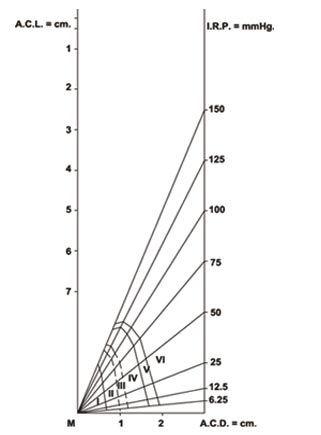| Back
to main page
The
Equation
Flow
Index calculator
Flow
Index & contispation
Defecation Norm Gram
Anal Incontinence
Continence Norm Gram
Applications of the Theory
Facts and Controversies
|
- 5
Curves were calculated and subsequently plotted on the norm
gram:
- Barium
Sulphate Continence Curve (Upper solid curve)
- Water
Continence Curve (middle solid curve)
- Barium
Sulphate Soiling Curve (Upper dashed curve)
- Water
Soiling Curve (lower dashed Curve)
- Air
Continence Curve (Lower Solid Curve)

The
above mentioned curves divide the norm gram into 6 Zones forming
the basis of a new functional classification of the degree of
severity of fecal incontinence as:
-
Grade I: Continent , anal staining
due to minor anal problem(e.g. Hemorrhoids), and incontinence
on top of normal anal Sphincter (e.g. fecal impaction).
- Grade
II: Gas
incontinence.
- Grade
III:
Fluid Soiling.
- Grade
IV:
Solid Soiling.
- Grade
V:
Fluid Incontinence.
- Grade
VI:
Solid incontinence.
- Each
grade from II - VI is assigned with Letters P, S or U (as an
indication for passive, stress or urgency anal incontinence
respectively) in order to signify which measurements are to
be used in calculation of Flow Index or in the Norm grams.
Allocating
each patient on the norm gram is done in the same way as in
defecation Norm gram (vide supra).
- Discrepancies
between mathematical Anal incontinence despite absence of clinical
incontinence is considered as sub-clinical sphincter weakness
which may be unmasked later on. E.g. a patient with sub-clinical
gas incontinence may be masked by minimal amount of bowel gas
produced in his bowel. Similarly a patient with mathematical
stress fluid incontinence my be apparently normal because he
has to have watery diarrhea simultaneously with an attack of
chest infection to start to have clinical incontinence.
|

